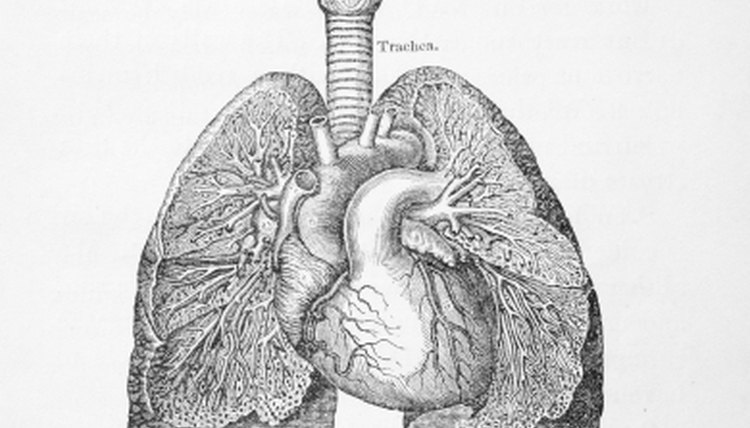Why Does the Right Lung Have 3 Lobes and the Left 2?

The Right and Left Lung
Human lungs are divided into right and left lungs, and further subdivided into lobes. The right and left lung are not symmetrical, since your right lung has three lobes and your left lung has two. The lobes on both sides of your lungs are separated by fissures. The oblique fissure separates the largest lobe, the left upper lobe, or superior lobe, from the one below it. The lower is called the left lower, or inferior, lobe. The right lung's lobes are separated by the horizontal fissure, dividing the superior and middle lobe, and the oblique fissure, dividing the middle and lower lobe.
Lung and Heart
The left lung is a little smaller than the right lung, since your heart is a little left of center of your chest. The heart, found in between the left and the right lung, occupies some of the space where your left lung is found. The two-lobed left lung makes room for your heart. A diagram showing a cross section of the lung lobes and heart reveals the left lung partially surrounding the heart.
Further Lung Divisions
Lungs continue to subdivide, the lobes becoming lobules. There are about 130,000 lobules, measuring 3.5 millimeters across. Lobules, in turn, have smaller bronchi branching off of them. Bronchi continue to branch and finally end in a complex system of air sacs called alveoli, numbering three million. Tissue located there is so thin that it would take 50 layers laid on top of each other to attain the thickness of tissue paper. This is the where the gas exchange takes place and your blood becomes oxygenated. It only takes about one minute for all your blood to pass through the lungs when you are at rest.You take around 25,000 breaths each day, inhaling over 10,000 liters of air. Heart and lungs work together in close cooperation to maintain your blood at a properly oxygenated level.
References
- National Cancer Institute SEER Training Modules. Anatomy of the lung.
- Kids Health from Nemours. Your lungs & respiratory system.
- Teach Me Anatomy. The lungs. October 22, 2019.
- Chaudhry R, Bordoni B. Anatomy, thorax, lungs. StatPearls. Updated January 13, 2019.
- Poe E, Granite G. Anatomical lung variations: A study conducted on cadaveric specimens. International Journal of Anatomical Variations. May 24, 2019.
- George BM, Nayak SB, Marpalli S. Morphological variations of the lungs: a study conducted on Indian cadavers. Anat Cell Biol. 2014;47(4):253-258. doi:10.5115/acb.2014.47.4.253
- Kc S, Shrestha P, Shah AK, Jha AK. Variations in human pulmonary fissures and lobes: a study conducted in Nepalese cadavers. Anat Cell Biol. 2018;51(2):85-92. doi:10.5115/acb.2018.51.2.85
- The Lung Association. How the lungs work. December 10, 2016.
- Medline Plus. Lung disease. Updated July 28, 2018.
- World Health Organization. The global impact of respiratory disease.
- NIH U.S. National Library of Medicine Genetics Home Reference. Idiopathic pulmonary fibrosis. April 28, 2020.
- American Lung Association. Learn about sarcoidosis. February 27, 2020.
- Hoeper MM, Ghofrani HA, Grünig E, Klose H, Olschewski H, Rosenkranz S. Pulmonary hypertension. Dtsch Arztebl Int. 2017;114(5):73-84. doi:10.3238/arztebl.2017.0073
- Bĕlohlávek J, Dytrych V, Linhart A. Pulmonary embolism, part I: Epidemiology, risk factors and risk stratification, pathophysiology, clinical presentation, diagnosis and nonthrombotic pulmonary embolism. Exp Clin Cardiol. 2013;18(2):129-38.
- American Lung Association. Lung capacity and aging. March 11, 2020.
- MedlinePlus. Lung function tests.
Writer Bio
Ruth Taylor is a teacher and a freelance writer. She has been writing for years, but only recently started freelancing. Her articles have appeared in Livestrong, eHow and other websites. In college she majored in Spanish and graduated summa cum laude with a M.A.T. in teaching a second language. She has taught both in high school and elementary school.
